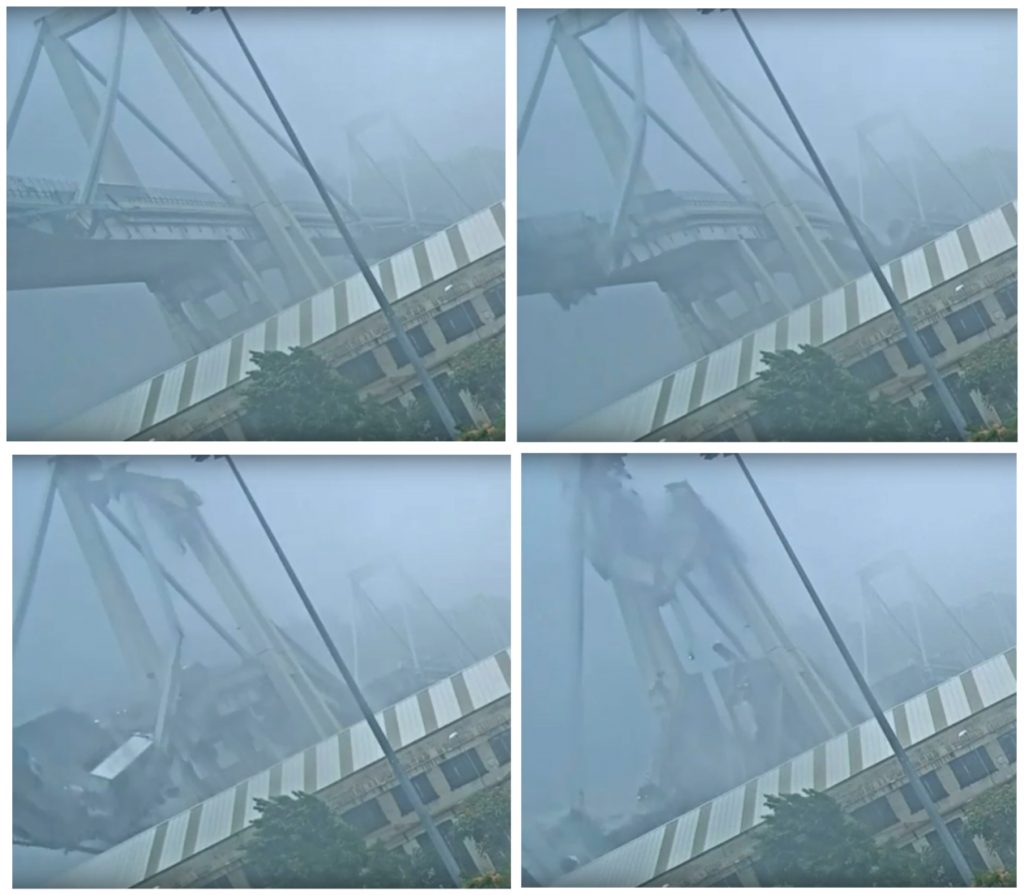Ponte Morandi, Genoa. The tower on the left, and the adjacent roadway, collapsed on August 14, 2018. Picture attribution: Salvatore1991
A terrible tragedy occurred in Genoa, Italy on August 14, 2018. A suspension bridge in that city, part of the A10 motorway, collapsed into the bed of the Polcevera River, 150 feet below. Forty-three people who were driving over the bridge were killed.
The cable-stayed bridge
The bridge in Genoa, called the Ponte Morandi after its designer, Riccardo Morandi, was opened in 1967. Morandi had designed several similar bridges internationally. It was a cable-stayed bridge, a design heavily used in recent times. There are variations, depending on how the cables are attached between the towers and the roadway. The Port Mann Bridge outside Vancouver, British Columbia, is a typical cable-stayed bridge:
![Dgarte [CC0] The Port Mann cable-stayed bridge.](https://commonsciencespace.com/wp-content/uploads/2019/07/1024px-Vancouver_Portmann-Bridge_2015-1024x576.jpg)
The Ponte Morandi, by contrast to other cable-stayed bridges, had only four stays between each tower and the deck. The numerous stays seen in typical bridges, such as the Port Mann, are made of steel. In the Ponte Morandi, these stays were made of pre-stressed concrete with embedded steel reinforcing rods. Steel was in short supply in post-war Italy, and Italian engineers turned to concrete as a substitute. When it was built, the Ponte Morandi was a point of pride in Italy.
The western tower, the leftmost one in the picture at the top, and the stays attaching the roadway to it, were destroyed in the collapse, and a 300-foot section of the deck plunged into the riverbed.

A video of the collapse taken from a nearby industrial site appears to show that the collapse began with the failure of a stay attaching the westernmost tower to the bridge deck, followed by toppling of the tower and collapse of the remaining three stays. The exact sequence of events is still under investigation.

The two remaining towers were brought down with explosives on June 28, 2019.
Forensic analysis of the collapse of Ponte Morandi
The consequences of the collapse of Ponte Morandi were profound. Many aspersions were cast as to who was to blame. The first question, however, is why did a bridge that was barely 50 years old fall down? The proximal cause lies in the chemistry of concrete.
There is a lot of concrete in the world, particularly the kind made from Portland cement, aggregate (sand and gravel), and water. One estimate is that the weight of concrete exceeds the weight of all trees, bushes, and shrubs in the world. I don’t know about that, but it is true that a prodigious amount is laid down each year. Currently, about 5 billion tons, which is enough to pave a 4-lane highway from Paris to the moon with 30 cm of concrete.
Concrete used in construction is the result of a chemical reaction between Portland cement and water. Aggregate, in the form of sand and/or small gravel, is usually included in the mix, but it doesn’t take part in the chemical reaction that produces the concrete. The cement used to make concrete (we often confuse the two terms) starts out as quarried limestone, with calcium carbonate, CaCO3, as the key ingredient. It is first broken up into small pieces, and these are heated to high temperature to drive off CO2, producing calcium oxide, in various combinations with other minerals. The resulting mineral is then ground to fine dust, and it is this “Portland cement” that reacts with water to produce concrete.
The production of cement worldwide produces a lot of CO2. A Guardian article (1) says that if cement were a country, it would be the world’s third largest emitter, responsible for 4-8% of the world’s output. China is by far the largest producer of CO2related to cement production. Cement production also consumes a large amount of energy and water (almost 10% of all water used in industry).
Concrete is a good material for many purposes; it doesn’t compress, and under the right conditions it can support enormous static loads and lasts almost forever. Concrete structures built by the Romans, including parts of the Colosseum, contained a mixture of minerals that has caused them to weather particularly well. However, concrete doesn’t have much tensile strength; it doesn’t do well subjected to a stretching force. To overcome this limitation in construction of structures that undergo tension, such as the stays of the Ponte Morandi, reinforcing steel is included, in the form of steel rods placed into the concrete.
Concrete reinforced with steel is strong and versatile. But it has a potentially fatal weakness. If the steel rods come in contact with water, or if enough carbon dioxide seeps in to lower the normal alkaline pH of the concrete, they begin to corrode. The steel reacts with oxygen in the air to return to its native state of iron oxide. This iron oxide, rust, has a greater volume than the steel it is produced from, and forces an expansion of the concrete embedding it. The concrete will crack, and the structure may fail.
Engineers were aware of corrosion in the Morandi bridge towers and cables, which was causing the concrete to crack. In a 1979 report, Morandi himself recommended: “remove all traces of rust on the exposure of the reinforcements, fill the patches with epoxy resin, and cover everything up with elastomer of very high chemical resistance” (he died in 1989).
The bridge was under constant repair because of corrosion. As evidence of rusting accumulated, the middle and eastern towers had their stays strengthened by adding external steel cables, The western tower, which was the one that collapsed in 2018, was not strengthened. Warnings about the condition of the bridge were given to the Italian parliament, and experts advised that the Morandi Bridge needed better maintenance.
The reliance on just four cable-stays from each tower has been criticized, as has a failure to estimate “concrete creep”, which disturbed the deck surface in the early decades of the bridge’s life. Also, the load carried by the bridge, the amount of traffic passing over it, was much higher than planned for.
Was Benetton pulling the wool?
The original design and inadequate maintenance of the bridge’s structure were the identifiable sources of the tragedy. But underlying the maintenance issue lay a more fundamental problem, which was that the bridge was privately owned, and it was being inspected for safety by an organization that was controlled by its owners. A recipe for failure.
In the 1990s, the government of Italy was undergoing a financial crisis, but wanted desperately to switch from the lira to the soon-to-be-introduced euro of the European Union. To reduce its debt and stabilize its finances, the government decided to sell off a variety of state-owned industries and infrastructures. Seventy transactions resulted in raising more than 100 billion dollars. The concession to operate the toll highway system, Autostrade per l’Italia, was one of the last properties to be auctioned off.
The successful bidder to acquire 30% of Autostrade, which included the Ponte Morandi, was controlled by the Benetton family, of clothing fame. Benetton was beginning to face fierce competition from cheaper clothing lines, and wanted to diversify. (In 2003 Benetton increased its holding of Autostrade to 85%, and was given a term extension to 2038). The deal is financially beneficial to the government, which in addition to the original sale realizes income from taxes and license fees. Benetton benefits because it has diversified its business, and, thanks to the former government of Silvio Berlusconi, is allowed to raise tolls every year.
Private ownership of a public facility like the Ponte Morandi might still be acceptable, if stringent safety inspections were being carried out by an arms-length agency. A company called Spea Engineering, from Milan, was carrying out the bridge inspections. Another company, Atlantia, owned Spea. And the main shareholder of Atlantia is Benetton. In other words, the operator of the bridge is also the inspector of the bridge. The Ministry of Infrastructure and Transport, nominally responsible for highway safety, does almost no inspections; it depends on documents provided by Spea. More than the concrete was rotten.
After the tragedy, the Benetton Company, which likes to be seen as a fashion-forward clothing designer (cf. “The United Colors of Benetton”), but which has faced some other contentious issues in recent years, was shtum for 48 hours. Then there was a statement, expressing “deep sympathy” for the victims, issued by the family holding company. The dying patriarch, Gilberto Benetton, explained that the silence was a mark of respect. Not surprisingly, the public response was outrage.
Poor design, inadequate maintenance, and a conflict of interest in the management structure: a perfect trifecta for disaster. The story continues. A criminal inquiry, which has named 21 people, is ongoing.
Go to Latest Posts
Sources
- Jonathan Watts, “Concrete: The Most Destructive Material on Earth”, The Guardian, February 25, 2019.
- David Segal and Gaia Pianigiani, “Genoa Bridge Collapse Throws Harsh Light on Benettons’ Highway Billions”, The New York Times, March 5, 2019




